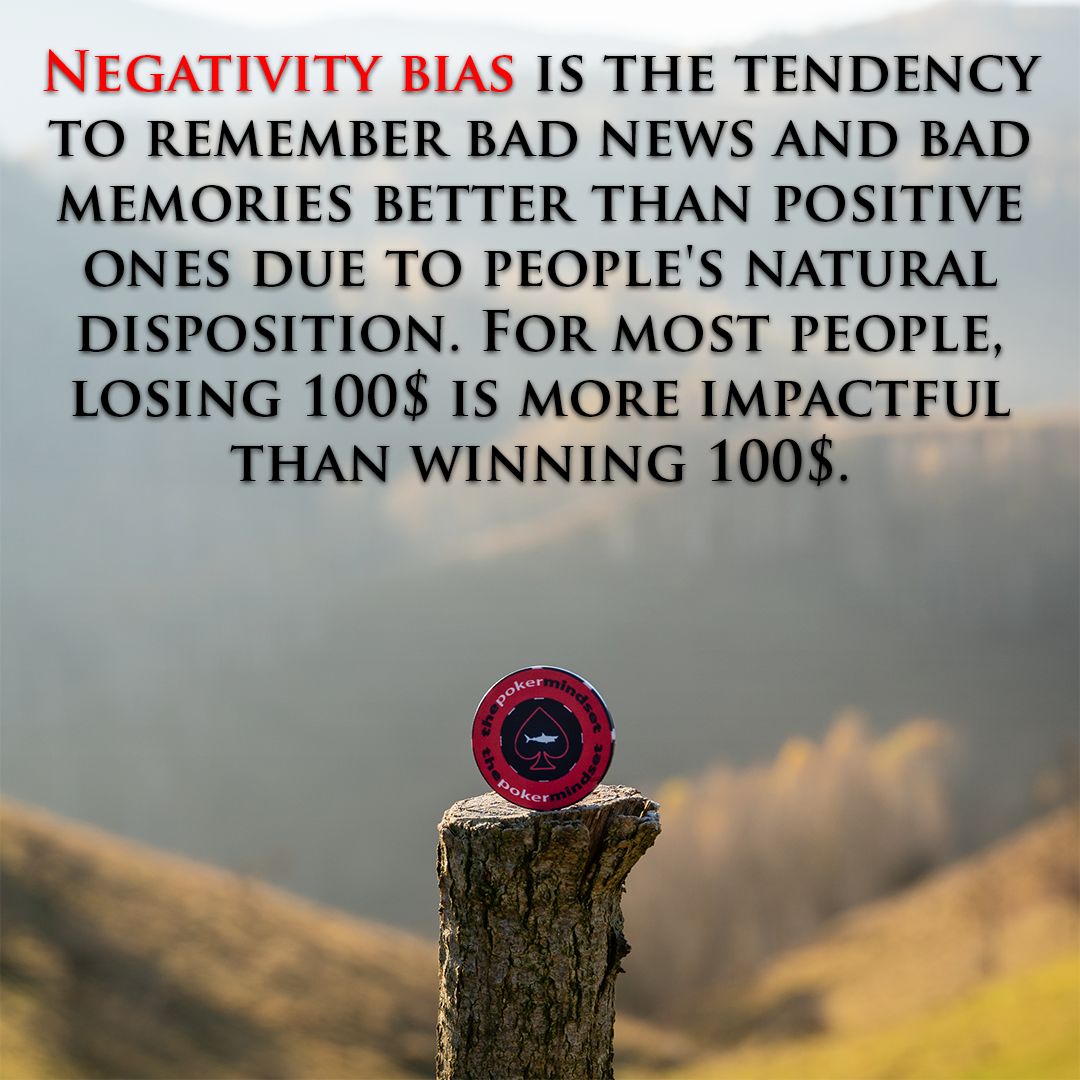In psychology, negativity bias refers to the tendency to remember bad news and bad memories better than positive ones due to people’s natural disposition. For most people, losing 100$ is more impactful than winning 100$.
This causes poker players to place more weight on the negative outcomes of their hands or sessions. The ability to play effectively can be affected if you are negatively inclined, or pessimistic. Poker players who are susceptible to negativity bias tend to panic, change their decisions rashly, or fail to act at all.
Negativity bias extends beyond the momentary emotional impact and is reflected in our long-term memories as well. As a result, we can recall bad memories from the past more readily than good ones. Furthermore, people consistently overestimated the frequency of bad events compared to good events when asked to estimate their frequency.
As Mike Caro, the Mad Genius of Poker said: “All losers exaggerate because they want you to know how bad they feel.”
Negativity bias in poker
Unsurprisingly, the negativity effect has a significant impact on poker players performance since it is one of the most powerful aspects of human psychology.
The fact that one may react negatively to negative events is not odd, though it is important to remember that negative events tend to trigger a stronger reaction than positive ones.
An important cognitive bias associated with negativity bias is loss aversion, which explains psychologically why losing hurts twice as much as winning the same amount of money.[1]
Negativity bias in poker impacts our risk aversion. It’s hard to accept but bad poker results are an inevitable and natural part of the game. It’s even more difficult to digest the bad results in order to move forward and achieve success. When you let strong emotions drive your plays, you are more likely to make irrational decisions.
For example, a player whose bluffs were called a couple of times during a session might feel that he is being destroyed and then start bluffing way less, thereby losing a lot of value.
Or on a wider level, an inexperienced player might associate a certain hand with bad results (or even worse, with bad luck) due to a short sequence of losses they suffered while playing them. As a result, they might avoid playing the hand and miss profitable spots.
A simple guide for those ’negative’ days
Whether in poker or in life, bad things will happen and it’s not a matter of “if”, but of “when.” And bad things usually come with momentum when they occur. It is not because bad things happen in strikes, but because of the negativity bias we unconsciously look for more bad experiences anywhere after a bad experience.
Have you ever caught yourself thinking: „Damn, nobody folds to my bluffs today” or „WTF, they always hit their magic card”? We are humans and we all experience the negativity bias in poker, I think there’s no poker player who is completely immune to it.
How to avoid negativity bias in poker
The first step to avoiding negativity bias in poker is to understand the bias and recognize how it affects your thinking and decision-making. Once you gain a general understanding the following can help you:
Mindfulness
Based on Kiken and Shook’s 2011 research, mindful breathing has been shown to increase positive judgments in participants and to engage higher levels of optimism. The participants of the study who practiced mindful breathing scored higher at tests where they had to categorize positive stimuli. The conclusion of the research was that practicing mindfulness has a positive impact on the negativity bias.[2]
Quick exercise:
After a bad day or poker session spend some time in solitude. This will help you put things into perspective and re-focus your attention on what’s important.
Look inward and face your discomforts. The pain and the negative outlook are usually the result of a story going on in your head. Notice the story. It’s irrelevant whether the story is real or not. Just notice it. There are waves of these thoughts and the more you get stuck repeating yourself this story, the more miserable you’ll feel.
Now, turn your attention to the present moment, and be willing to feel and accept everything, instead of avoiding it or hating it. Remember, your mind will always try to run away from discomfort and pain. Although this is a good strategy to temporarily avoid dealing with difficulties, you’ll never learn to deal with what’s inside you and what’s in front of you.
Let your mind explore all the pains and discomforts and stop trying to avoid them. Face them! Face your fears, discomforts, and difficulties in the present moment. Not the story you’re repeating in your head, but the physical feelings you’re experiencing in your body right now.
How bad are these feelings? You’ll find that it’s not a big deal at all. Make sure you stay with them for a while. When you do so, your negative outlook will clear up, and your misery will dramatically decrease.
Of course, this exercise won’t resolve all of your problems, but I can promise you that as you get better at it, you’ll be able to cope with many more. Instead of running away from discomforts, you’ll learn to deal with them. With practice, not overnight.
We have compiled a list of the best online poker sites with the most generous sign-up bonuses, smoothest software and softest games. Click here to check it out!
References
- Kahneman, D., & Tversky, A. (1977). Prospect Theory. An Analysis of Decision Making Under Risk. doi:10.21236/ada045771
- Kiken, L. G., & Shook, N. J. (2011). Looking Up: Mindfulness Increases Positive Judgments and Reduces Negativity Bias. Social Psychological and Personality Science, 2(4), 425-431. doi:10.1177/1948550610396585


